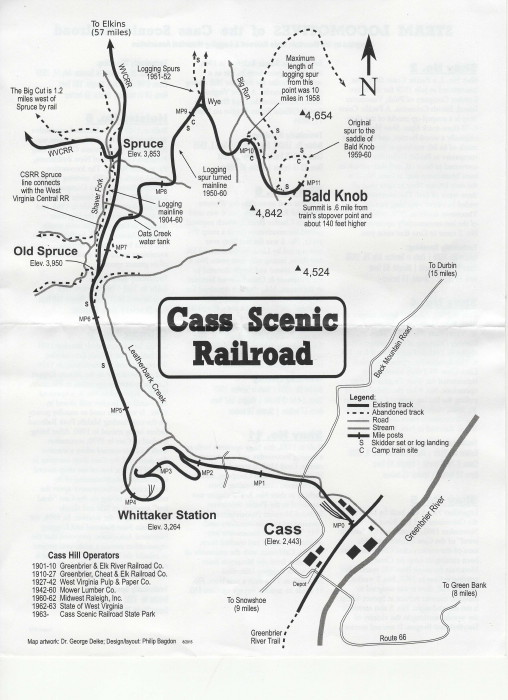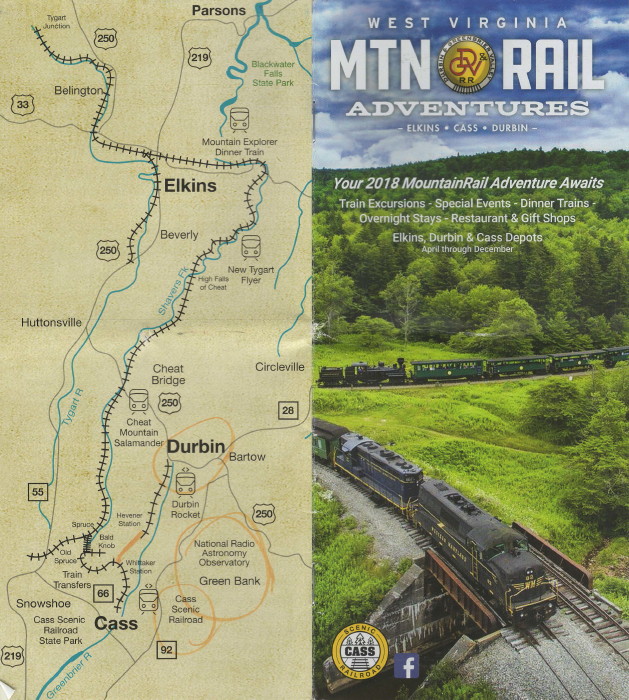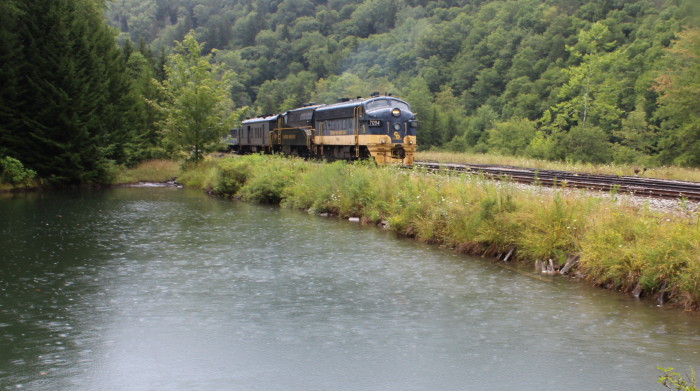Text and Photos by Author
The
author retains all rights. No reproductions are allowed
without the author's consent.
Comments are appreciated at...yr.mmxx@gmail.com
The town of Cass was always centered around the lumber companies that inhabited the valley and operated the West Virginia Pulp and Paper Mill. The mill operations were enormous during its heyday period of 1908 to 1922. It ran two 11 hour shifts six days a week, cutting 125,000 board feet of lumber each shift, an impressive 1.5 million feet of lumber a week. The Cass mill also had a drying kilns using 11 miles of steam pipe to dry 360,000 board feet of lumber with each run. The adjoining planning mill was three stories tall, measuring 96 by 224 feet. Massive elevators carried up to 5,000 feet of lumber to separate floors and machines. Some of the flooring machines took 15 men to operate them. There were two re-saws that could accommodate boards up to 35 feet. The large surfacing machines finished all four sides of a board in one operations. Roy Clarkson in Tumult estimated that in 40 years the Cass mill and the mill in Spruce turned more than 2.14 billion feet of timber into pulp or lumber. The town of Cass was named after Joseph K. Cass. Each morning the C&O RR dispatched a 44 car pulpwood train for the paper mill at Covington. At the peak the West Virginia Pulp and Paper Mill employed between 2,500 and 3,000 men. In an average week six to ten carloads of food and supplies traveled over the railroad to the 12 logging camps.
At the turn of the century lumberman were eyeing the large tracts of timber on Cheat Mountain, west of Cass. They decided to route the timber east through a gap in the mountains and down the steep grade to the Mill at Cass. An interchange with the C&O Railroad would be at Cass with a route down the Greenbrier and Elk River to the C&O mainline. In 1900 Samuel Slaymaker, a timber broker, set up a construction camp at the mouth of Leatherbark Creek {the present site of the Cass shops today}. His men built the line up the grade following the Leatherbark Creek and gained altitude by constructing two switchbacks. The tracks were laid around a promontory and then upgrade winding along the ridge to where the rails reached the gap in the mountains. Here a camp named Old Spruce was established. In 1904, 1-1/4 miles of track was laid from Old Spruce to Spruce where a new town on the Shavers Fork of the Cheat River was built. At an elevation of 3,853 feet, Spruce was the highest town in the eastern United States. From Spruce the tracks ran 35 miles south into the Elk River Basin to the town of Bergoo and 65 miles north along the Shavers Fork. Spruce became the hub of the rail empire. The mainlines ending up being 82 miles long and at the height of operations about 140 miles of track including the branches were used. The logging railroad built about 250 miles of more tracks. The Greenbrier & Elk River in 1909 became the Greenbrier, Elk & Valley Railroad and in 1910 became the Greenbrier, Cheat & Elk Railroad. In 1910 this railroad became a common carrier. In 1926 a merger of the Greenbrier, Cheat & Elk Railroad and Western Maryland Railroad which wanted to tap the rich coal reserves of the region. On March 3, 1927 saw an agreement reached and the Western Maryland purchased 74 miles of the railroad between Cheat Junction and Bergoo. Shays were used to pull the coal trains until the line was rebuilt to accommodate the massive WM H-8 2-8-0's. Up to ten locomotives were used to pull coal trains up the steep grade. In 1925 the town of Spruce began to die when the peeling mill closed. In the 1930's the town became an isolated helper station on the Western Maryland. With the coming of the diesels, all locomotives serving Cass were transferred to Laurel Bank and Spruce became a ghost town. Mower Lumber Company acquired the Cass operations in 1942 to cut second growth timber on Cheat and Back Allegheny Mountains. Rails we relaid into old logging areas. Huge steam skidding machines were rigged on hillsides and knobs, bringing saw logs for the mills on rail lines. But the second growth timber couldn't feed the mighty mills for long. By the 1950's the mill was working a single shift. The big four-truck shays languished on sidings while tired three-truck shays 1, 4 and 5 were assigned to the hill. With Edwin Mower's death in late 1955, the family members were unable to keep the operations going. The rail-haul logging operations and bandsaw mill ceased operations on July 1, 1960. A scrap dealer, the Midwest Raleigh Corporation was subcontracted to dismantle the railroad.
In late September 1960, a rail fan, Russel Baum of Sunbury, Pennsylvania initiated an effort to save the railroad. Baum reasoned that the shays and old logging track could become a big tourist attraction. A small group of local businessman formed the Cass Planning Commission and State legislators were approached. Skeptical officials initially declined to participate. But when the state legislature's prestigious Joint Committee on Government and Finance took an inspection trip over the former Mower Lumber "Railroad to the Sky" to Bald Knob, the bureaucratic wheels were set in motion. During the State Legislature's regular sessions in early 1961 an appropriation was approved and the governor of West Virginia signed a bill bringing Cass into the West Virginia State Park System. The Midwest Raleigh Corporation received $125,000 for the seven miles of mainline from Cass to Spruce and four miles from Old Spruce to Bald Knob. Also included were three locomotives, 10 flat cars, four camp cars, three motor cars and other equipment. It wasn't until 1963 that Shays 1 and 4 were put back into service and safety railing and benches were installed on a few flat cars. Trains went about halfway up Back Allegheny Mountain above the switchbacks to a pleasant pasture now known as Whittaker Station. At that point, there wasn't enough money yet to fix the tracks to Bald Knob. In 1968 the line to Bald Knob was restored. Since 1985 the West Virginia Department of Commerce has proceeded with its plans to restore the town of Cass.
Cheat Mountain Salamander and the Durbin and Greenbrier Valley Railroad HistoryNamed in honor of the little endangered creature whose sole habitat is the river of the same name, the Cheat Mountain Salamander takes you through some of the wildest mountain wilderness you will ever experience! Travel into the high country forests of legendary Cheat Mountain on this most distinctive rail excursion, featuring great mountain vistas. Choose between Elkins Depot and Cheat Bridge departures. This trip includes a cold sandwich buffet served en route.
This trip also includes many interesting features such as a long tunnel built with an "S" curve far underneath Cheat Mountain, numerous long mountain vistas, and many opportunities to view exotic wildlife including bald eagle and black bear sightings. Stopovers include the inspirational "High Falls of the Cheat" and the former sight of the notorious town of Spruce, WV, once the highest and coldest incorporated town east of the Mississippi, accessible only by rail.
The Durbin & Greenbrier Valley is a tourist railroad based in Durbin, West Virginia operating over five miles of the Chesapeake & Ohio Railway's former Greenbrier Division, most of which today is a state-owned rail/trail (the Greenbrier River Trail). And, like the trail, the D&GV is owned by the State Rail Authority. While the railroad does not offer a long train ride like some other tourist lines, or even a nice dinner with its trip, it does allow for spectacular scenic views of West Virginia's Appalachian Mountains along the banks of the Greenbrier River. And for those interested in rail history, the Durbin & Greenbrier Valley features an operating Climax geared steamed locomotive, originally built in 1910 for the Moore-Keppel Lumber Company in Randolph County.
The Durbin and Greenbrier Valley Railroad is actually one arm of an increasingly popular tourist line, the West Virginia Central. The trackage operated by both the WVC and D&GV are owned by the State Rail Authority of West Virginia. However, their operations are under contract to the owners of the D&GV (the company also provides all freight services along the Elkins portion of the line). Today, along with the D&GV's popular train, The Durbin Rocket, the WVC operates climate-controlled tourist trains along parts of the old Western Maryland Railway around Elkins (complete with locomotives painted in WM livery), which include the New Tygart Flyer, Cheat Salamander, and Mountain Explorer Dinner Train.
The WVC itself came to life in 1998 when the State of West Virginia won a long legal battle with CSX to keep the rails in place between Tygart Junction and Bergoo, West Virginia (some 140+ miles of railroad) with a right to purchase them, which it quickly did. After finding an operator in the way of John and Kathy Smith, owners of the nearby little Durbin & Greenbrier Valley and a real knack for running a railroad, the West Virginia Central has really taken off over the past ten years.
The railroad's latest milestone includes moving its headquarters to the former WM two-story brick station in Elkins, once home to the "Wild Mary's" large freight yard which served as both its western terminus as well as staging operations for the numerous coal branches that once fanned out around the Elkins area. In the early 1990s CSX, with the loss of coal mines and traffic in the region moved to close the yard, ripping up the tracks and removing the bridge that was used to access the yard.
Overall, the management side of the operation can be a bit confusing although what was originally known as the "Durbin and Greenbrier Valley Railroad" began along a small stretch of former C&O trackage in Durbin, West Virginia. It did not expand into its present day operation of running the West Virginia Central until the late 1990s. The little operation is unassuming, as you might actually miss it driving through Durbin along route 250 although the original C&O depot (painted in a cheerful light yellow with white trim) does help to catch one's eye!
Today, what is now known as The Durbin Rocket still remains isolated from the rest of the West Virginia Central system. The line once reached Cass where the popular Cass Scenic Railroad now operates (and now too has a connection with the WVC at Spruce) but a massive flood in 1985 destroyed much of the right-of-way south of Durbin. The operation still hopes to slowly rebuild the several miles to Cass although with very limited funds available the best hope of that actually happening is still several years away.
In any event, if you are interested in riding The Durbin
Rocket, Durbin is located about 40 miles to the south of
Elkins along route 250 and their schedule mostly operates on
the weekends from May through October. You may also purchase
reserved seating in advance although to do so you will need to
either visit their website or call ahead. And on that note,
please click here to visit their website and learn more about
all of they have to offer (tickets can also be picked up
directly in the depot).
The West Virginia Central and Pittsburgh Railway History
The West Virginia Central and Pittsburgh Railway was a railroad in West Virginia and Maryland operating in the late 19th and early 20th centuries. It had main lines radiating from Elkins, West Virginia in four principal directions: north to Cumberland, Maryland; west to Belington, WV; south to Huttonsville, WV; and east to Durbin, WV. Some of the routes were constructed through subsidiary companies, the Piedmont and Cumberland Railway and the Coal and Iron Railway. was a railroad in West Virginia and Maryland operating in the late 19th and early 20th centuries. It had main lines radiating from Elkins, West Virginia in four principal directions: north to Cumberland, Maryland; west to Belington, WV; south to Huttonsville, WV; and east to Durbin, WV. Some of the routes were constructed through subsidiary companies, the Piedmont and Cumberland Railway and the Coal and Iron Railway.
West Virginia businessman Henry G. Davis founded the Potomac and Piedmont Coal and Railroad Company in 1866. In 1880 the company began to construct a rail line from a junction on the Baltimore and Ohio Railroad (B&O) near Bloomington, Maryland, south along the North Branch Potomac River. In 1881 the line reached coal fields near Elk Garden, WV, and Davis obtained new charters from the states of West Virginia and Maryland, renaming the company as WVC&P.
By 1884 the line reached Fairfax, WV and the location of the future town of Davis, WV. Davis became a center for logging, sawmills and leather tanning, and in the 1890s it was the starting point for the rapidly growing Davis Coal and Coke Company. In 1886 the WVC&P began construction north from the Bloomington junction toward Westernport, Maryland and Cumberland, using a newly created subsidiary, the Piedmont and Cumberland. The P&C reached Cumberland in July 1887. Connections with the B&O were established at Cumberland and Rawlings, Maryland.
Southward construction on the WVC&P continued, and the line reached Parsons in 1888 and Elkins (formerly Leadville) in 1889. Elkins became a major hub for the railroad. A branch out of Elkins west and north along the Tygart Valley River was constructed and reached Belington in 1891. Another branch followed the river south, reaching Beverly in 1891 and Huttonsville in 1899.
In 1899 the WVC&P established the Coal and Iron Railway (C&I) to build a line from Elkins to Durbin.
By 1903 the line to Durbin was complete and a connection was made there with the Chesapeake and Ohio Railroad (C&O).
AcquisitionThe WVC&P and subsidiaries were sold to the Fuller Syndicate, led by George Gould, in 1902 and merged into the Western Maryland Railway in 1905. The newly built WM connected to the WVC&P in Ridgeley, WV. The WM was taken over by the Chessie System in 1973, and the Chessie System in turn was merged out of existence and into CSX Transportation in 1980.
Current OperationPortions of the original WVC&P lines are used by CSX for freight operations. Other portions are owned by the West Virginia State Rail Authority, which contracts with the Durbin and Greenbrier Valley Railroad to operate a tourist railroad from Elkins, Belington and Durbin.
In 2015, The Cass Scenic Railroad joined the Durbin & Greenbrier Valley Railroad's Mountain Rail Adventures roster providing new services such as the Wild Heart of West Virginia excursion, making rail and travel season even more exciting!The new "Wild Heart of West Virginia Adventure Package" offers a combined ride on two trains with one ticket - the Cass Scenic Railroad and the Cheat Mountain Salamander, with overnight package options in Elkins or Cass.
Visitors will ride steam-driven Shays of the Cass Scenic Railroad to Old Spruce, transfer to the diesel-powered Cheat Mountain Salamander, have an on board sandwich buffet lunch, spend the night in Elkins to enjoy multiple attractions and return by the same route to Cass on any scheduled return date.
On the other side of the coin, passengers can board in Elkins or Cheat Bridge, enjoying an on board sandwich buffet as they travel to Old Spruce. Once at Old Spruce, guests will then transfer to the Cass Scenic Railroad climbing upward to Bald Knob, the third highest point in the state. After the train descends back down the mountain into Cass, guests can stay in one of the historic company houses at the Cass State Park. This new wilderness excursion explores the most remote areas of the Mountain State some areas so remote that even automobiles cannot access! Take in the sights of West Virginia's most pristine rivers and enjoy the views of our mountains all by Mountain Rail.

We climbed the final 6% grade to Old Spruce where we hoped our Cheat River Salamander train would be waiting.
One of our conductors today already had Chris and I as his passengers from the Durbin Rocket a few days ago. Today, he is working for the Cass Railroad so it was really good to see him again.

We have finally reached Linan,
MP 60, where we will hold our first and only runby of the trip.
The train came to Linan in a light rain shower and some of the
passengers detrained for a photo runby. The train consisted of
Chesapeake & Ohio F7A 7094, Western Maryland BL2 82, West
Virginia Central United States Mail Railway Post Office 706,
West Virginia Central coach and Western Maryland coach 835. We
made a photo line and the edge of Linan Lake and waited for the
photo runby to start.
